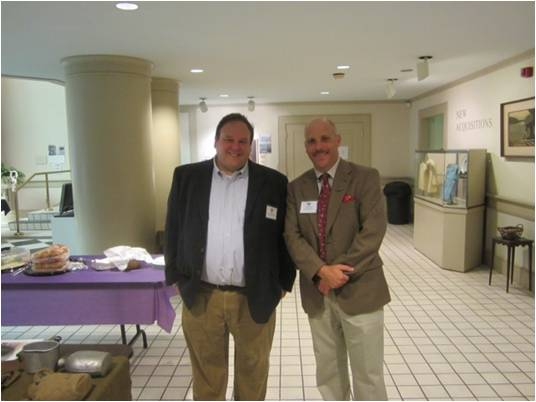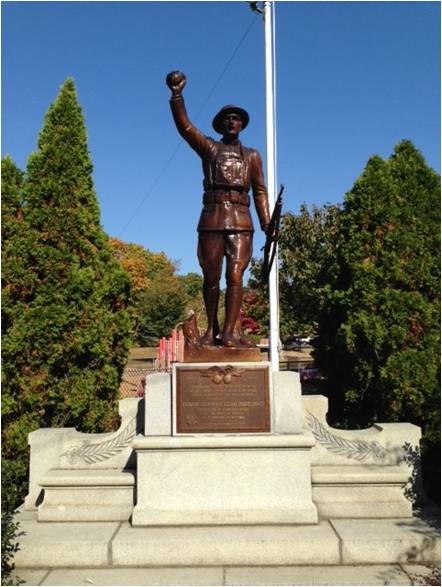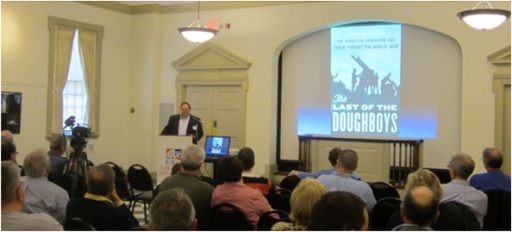The Western Front Association’s East Coast Branch held its Fall 2013 World War I History Symposium on the 12th October 2013 at the York County Heritage Trust, in Pennsylvania. Centenary News’ Dr. Jillian Davidson attended the event and writes about the symposium.
East Coast Chairman, Paul Cora hosted a day packed with enlightening speakers and lively discussions. He introduced his umbrella group, the Western Front Association, as the premier World War One remembrance organization in the world today.
Founded in the UK in 1980, the WFA now boasts more than 50 branches and 6,000 members in Western Europe, Canada, Australia, New Zealand and the United States. “It is an exciting time” Paul acknowledged enthusiastically, “to be studying the history and impact of World War One. We are on the cusp of the Centenary and people are showing an interest at a level we have not seen before.”
Like its parent body, WFA East Coast actively promotes the memory and study of the First World War through the sponsorship of WWI history conferences, the promotion of a wide variety of WWI-related events in the mid-east region of the United States, and the support of WWI-related museums and sites. Recently, to its credit, the WFA East Coast was instrumental in preserving the regimental band brass drum of the 313th Infantry in a custom-made exhibit case at the Maryland War Memorial Building.
Enriching memory
The group also sponsored “The Cher Ami Project” to make available an out-of-print World War One book (about the pigeon who saved the lost battalion) to schools and libraries. It’s also contributing to the World War I Centennial Network, a collaborative association of organizations, museums and historic sites dedicated to help America remember the First World War. The goal and slogan of the Network is “Working Together to Enrich Our National Collective Memory.”
Most of the symposium’s participants were old comers. Many people there had been coming to programs for 20 years and Paul Cora thanked them for their loyalty. “The wonderful thing about us,” he explained, “is that we know that everyone in our group has a contribution to make, there are all sorts of interests whether in battlefield tours, in genealogy etc.”
The WFA is not just about the big famous names; it makes a point of giving opportunities to young and passionate newcomers. In the lineup of this symposium, there was, for example, Ryan Szimanski who gave a talk on “A fleet second to none. The naval arms race before, during and after the First World War.” Paul recalled how he chanced upon Ryan reading a book on WWI battle cruisers for recreation while working at Historic Ships in Baltimore, where Paul is Museum Curator. Here was a rare find, he noted, worthy of a future speaking engagement.

Robert Dalessandro explaining the Centennial Commission’s Money Matters
Robert Dalessandro, a retired Colonel in the U.S. Army and the current Director of the United States Army Center of Military History at Fort Lesley J. McNair, came to York straight from Washington DC where he is currently serving as Vice-Chair on the Centennial Commission. Before giving his historical talk, he provided an in-depth update on America’s involvement in centennial commemoration. The bottom-line was that “The US is way behind!” Only as recently as September 13th, did the Commissioners hold their first legislated meeting in Kansas City, home to the National World War I Museum, and take their oath of office.
In establishing the Centennial Commission, Congress reported, “More than 4,000,000 men and women from the United States served in uniform during World War I, among them 2 future presidents, Harry S. Truman and Dwight D. Eisenhower. Two million individuals from the United States served overseas during World War I, including 200,000 naval personnel who served on the seas. The United States suffered 375,000 casualties during World War I, including 116,516 deaths.” The centennial of World War I provides an opportunity for Americans to learn about, commemorate and honor these sacrifices.
Grand schemes
Several “signature events” are in the very early stages of planning: two commemorative stamps, coins in 2017 and 2018, a mini-series, a Christmas special on the Christmas truce, academic conferences and guaranteeing the presence of the President at key commemorative events; for example, in Brussels in August 2014 to commemorate the American relief effort for Belgian civilians. Apparently, while there have been coins issued to commemorate other great conflicts including the Civil War, World War II, the Korean War and the Vietnam War, there have been no coins issued by the US to honor the veterans of World War I.
Jerry Hester, a member of the Centenary Commission, was formerly Chairman of the 70th Anniversary WWI National Committee and commissioned the 75th anniversary commemorative stamp. Another Commissioner, Edwin Fountain, was crucial in securing the WW2 national memorial. “If anyone can get us a WWI national memorial, he can.” Grand schemes indeed, especially considering that this is the first commission of its kind for which Federal Funds have been “prohibited.” Donations, such as $50,000 from The History Channel, are subsequently crucial to the Commission’s success.
It is the vision of the Commission to act as a clearing house for the dissemination of information about events and plans for the Centennial. Dalessandro turned to his audience and co-opted everyone: “You are our apostles!” Apostles, in the service of education, to teach young people “This war fundamentally changes the nation in every way.” Ironically, in the second part of his address, on “Willing Patriots” Dalessandro told the story of the prejudices and restrictions that threatened Black Americans, who nonetheless chose to serve their country in war. The high hopes these soldiers cherished for returning home to improved conditions were sorely disappointed.
Engaging imagination
As part of its own effort towards World War One education, the Commission plans to engage the imagination of Americans by mobilizing sports to its cause. They want to commemorate the start of the all American tradition of singing the anthem at baseball games and other events. “The Star-Spangled Banner” was played for the very first time at Game 1 of the 1918 World Series. Seventeen months into the war, the American government began to draft major leaguers for military service that summer and curtailed the regular baseball season to end by Labor Day. As a result, the 1918 Series saw the only October Classic played entirely in September.
 Author Richard Rubin and WFA East Coast Chairman Paul Cora
Author Richard Rubin and WFA East Coast Chairman Paul Cora
No doubt the most effective “apostle” at the York Symposium was Richard Rubin, whose book “The Last of the Doughboys” gave voice to the last surviving US veterans. Rubin became interested in World War One very early on as a child, though he can’t pinpoint the exact turning point. “Was it Snoopy? Some old documentary that was on TV in the background as I played with Legos on the floor? The framed portrait of my grandfather in his A.E.F. uniform that hung on the wall in my brother’s room? I don’t know, but I do remember, very vividly, my mother pointing out the Bronx VA hospital one day as we rode past it on our way into the city, and she told me – this was in the mid-1970’s, when I was maybe seven or eight years old – that there were still men in there who had never recovered from being gassed in World War I. That made a very strong impression on me. Clearly.”
When he heard on the radio in 2003 that one thousand veterans of the Second World War were dying every day and that we must hear their stories while still possible, Rubin wondered why no one sought to recover the stories of veterans from The First World War. He did the mental math and figured that any surviving veterans would be circa 106 years old, and then he began his own investigations as to their whereabouts. Racing against time, he discovered dozens of them and interviewed them before the last of them died.
Vivid memories
Rubin’s veterans remembered their war experiences vividly. Their long-term memory served them better than did their short-term memory. The best memory belonged to Samuel Benedict Goldberg, who seemed to possess near total recall. He also had the best or most “exquisite” diction of anyone Rubin has ever met; he articulated his name “Sam-ewe-elle, Ben-eh-dic-T, Gol-D-ber-G.” He remembered the exact date of his arrival in America from the Polish city of Lodz (December 27, 1907), the name of his ship and all his various addresses.
Rubin contrasted the abundance of memories he heard from his veterans with the dearth of communal memories amongst Americans nowadays. He further contrasted this absence of regard for World War One with the ubiquity of memorials to that war in this country and in France. Immediately after the war, America made unparalleled efforts to memorialize WWI. Rubin himself, as a boy, fell under the trance of a 1939 statue of a doughboy outside the public library in his hometown of Harrison in New York state.
 The statue of a doughboy in Rubin’s hometown of Harrison, NY
The statue of a doughboy in Rubin’s hometown of Harrison, NY
On his trips to the battlefields and war cemeteries in France, to museums, monuments and showcases of American war memorabilia there, experts have assured Rubin that stuff will continue to show up for the next 200-300 years. In a significant way, all of France is a memorial to WWI. The war was not fought on American soil, yet artefacts continue to be found in America too.
Rubin, like Paul Cora and Robert Dalessandro before him at the York Symposium, urged his audience: “There is a real opportunity for us to reclaim our memories and that starts here in this room.” He charged everyone present to pursue their own investigative work and hunt in their own attics or basements, on the chance of finding a draft notice, a postcard, a letter, an identity disk, a photo, a prayer book, or uniform buttons, such as Rubin himself found in his parents’ home belonging to his grandfather, Corporal Abraham Rubin.
Over the next four to five years, Americans will have to busy themselves with a lot of such historical reclamation, both physical and intellectual.
 Richard Rubin signing copies of his book “The Last of the Doughboys”
Richard Rubin signing copies of his book “The Last of the Doughboys”
© Centenary Digital Ltd & Author
